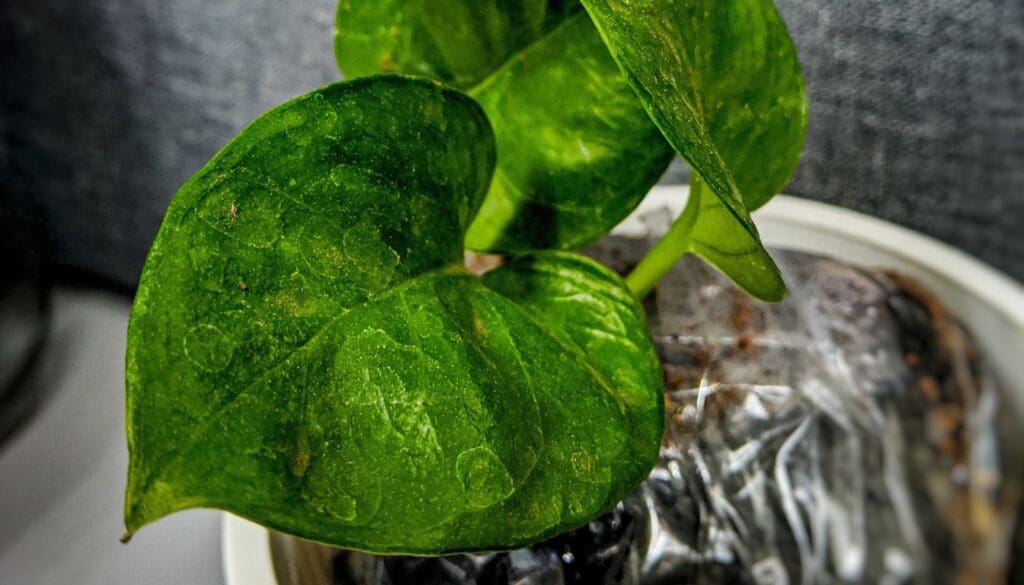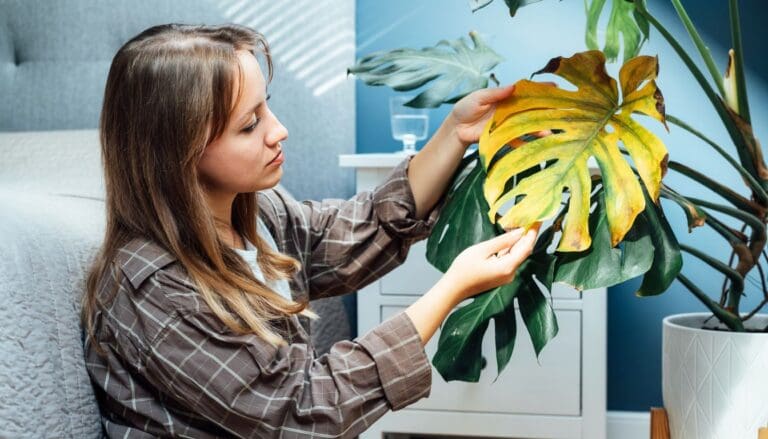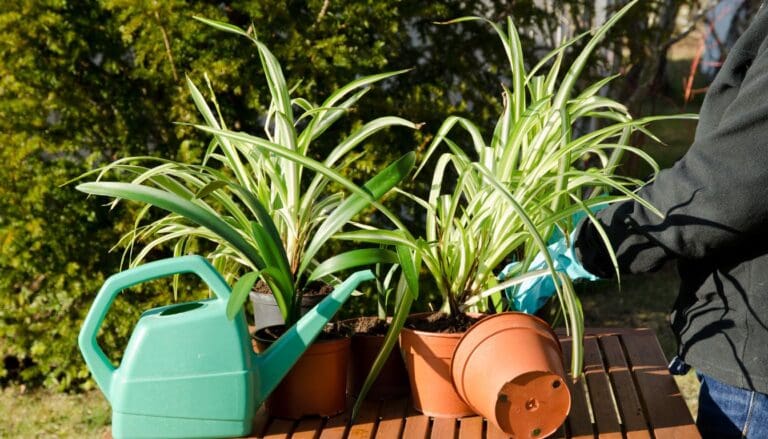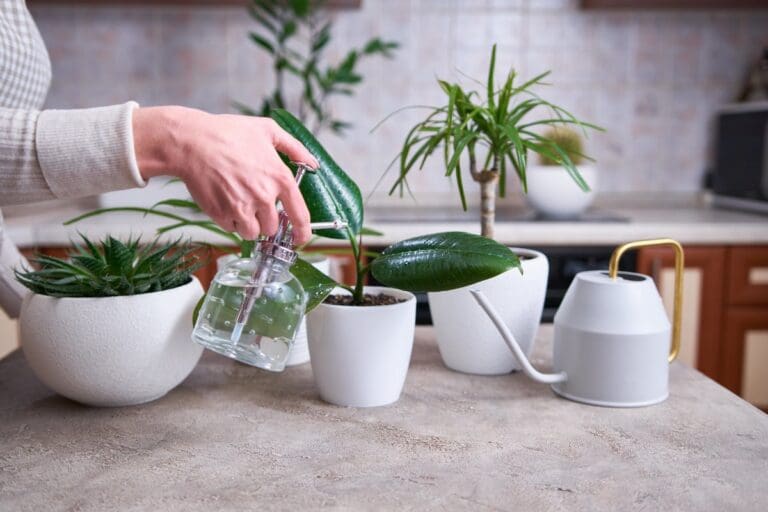Brown Spots On Pothos Leaves? 7 Causes & Easy Fix!
If you have Pothos in your house, you will encounter a phase where you will notice some brown spots on their shiny foliage. The problem is common yet concerning, and quick action is necessary.
Brown spots on Pothos can be caused by excessive moisture, pests, sunburns, fertilizer burns, bacterial and fungal infections, and rust. To help your Pothos recover, analyze its condition and address any issues quickly.
In this article, I will share all the common causes behind brown spots in Pothos, what to do about them, and some preventive measures and care tips to prevent brown spots and keep your plant healthy in the long run.

Please note: Simplify Plants is reader-supported. Some links in the post are affiliate links and I get a commission from purchases made through links in the post.
1. Excessive Moisture Leading to Brown Spots on Pothos
Root rot is common in houseplants, and Pothos are no exception.
It is caused by exposure to prolonged wet conditions.
When you overwater your Pothos, the roots suffocate and fail to pass the nutrients to moisture to the other plant parts.
Fungi that thrive in wet conditions, like Phytophthora or Pythium, can decay the roots and cause root rot in prolonged wet conditions.
These fungal spores can multiply in wet soil and survive for years.
The same occurs during poor drainage.
A poorly drained soil or a pot with no drainage hole holds the extra moisture. We know what happens after that.
Pothos leaf’s petiole will have a few brown spots that slowly spread across the leaves and other parts by water splashes.
You’ll also notice yellow or brown leaves, mold on the soil surface, and a foul smell from the plant base and soil.
Fixing root rot and adjusting the watering of Pothos to avoid brown spots
When you see the signs of root rot, your first step should be to isolate the plant. Next, follow up with the following steps:
- Trim the infected leaves and remove your Pothos from the pot to check the roots.
- The brown and mushy roots are the rotten roots that need removal. The white and firm roots are still not infected.
- If maximum roots have been damaged, you cannot save this plant. Collect some healthy cuttings and propagate them for new Pothos.
- If minimal roots require removal, trim them off and treat the good roots with fungicides to prevent further spreading of the spores.
- Make a new well-drained soil mix and a new pot 1-2 inches bigger than the old one, with drainage holes. Terracotta pots can wick away moisture faster; hence it’s great for gardeners who often overwater Pothos.
- After repotting, put your Pothos at a location receiving bright, dappled sunlight.
- Don’t feed it until you see signs of new growth.
- Avoid cold drafts. Maintain 65-90°F temperature and 50-60% humidity.
- You can make your own mix or buy a store-bought soil mix for the soil mix.
Other store-bought options are:
- Miracle-Gro Tropical Potting Mix
- House Plant and Tropical Plant Potting Soil
- FoxFarm FX14054 Happy Frog Potting Soil
- Want some soil mix recipes? Here are my two recommendations:
- Add 2 parts peat or coco coir, 1 part perlite, and 1 part pine bark fines.
- Mix one part cactus soil mix and one part compost.
Adjust the watering schedule for your Pothos after repotting.
I recommend checking the soil and watering when the top 2-3 inches are dry.
I water my Pothos every 5-7 days during the summer and every 10-14 days in winter (due to dormancy, Pothos absorb moisture slowly).
I always check the moisture level, let at least 40-50% of the soil dry, and then water it.
2. Low Humidity Causing Brown Spots in Pothos

Pothos plants thrive in humid air, preferring it over damp soil. Hence, they enjoy high humidity, around 60-70%.
But since it can be uncomfortable indoors, at least 50-60% humidity should be ideal.
When the humidity around your Pothos is extremely dry, the leaves start losing moisture faster and become dry and crispy.
Slowly, your leaves will have small brown spots or patches. The entire leaf will turn brown if you don’t adjust the humidity.
Increasing humidity levels for Pothos having brown spots
First, check the humidity using a humidifier. If it’s lower than 40-50%, here are a few options to adjust it:
- Install a humidifier.
- Mist your Pothos regularly.
- Put a pebble tray under the pot. As the water evaporates, it adds moisture.
- Group multiple tropical plants.
- Keep an aquarium or water tank near your Pothos. It works like pebble trays.
Trim the heavily spotted leaves to enhance the plant’s appearance and promote new growth.
3. Sunburns Triggering Brown Spots on Pothos Leaves
Pothos enjoy staying under bright, dappled sunlight for 10-12 hours.
While some direct sunlight, for 3-4 hours, in the early morning is fine, too much exposure will cause sunburns.
Direct sunlight can cause brown spots or patches on Pothos leaves, especially on the surfaces, tips, and edges.
These spots will enlarge, the entire leaf will turn brown, and then fall off the plant.
Adjusting the light conditions to treat brown spots in Pothos
If there are brown spots on your leaves, check the light conditions.
If the plant receives direct sunlight, shift your plant 8-9 feet away from the plant.
Use sheer curtains or Venetian blinds to filter the direct sun, primarily the sunlight from south and west-facing windows.
East-facing windows provide perfect gentle sunlight.
You don’t have to use curtains or Venetian blinds to filter the light.
4. Fertilizer Burns Creating Brown Spots in Pothos
Some fertilizers have harmful chemicals.
Using them too much can burn the Pothos leaves and create brown spots.
The spots are like patches that enlarge if you continue using these products.
These chemical fertilizers can remove maximum moisture from the roots and dehydrate them.
The problem escalates when you use these products to dry Pothos during hot weather.
Avoiding fertilizer burns to control brown spots
Keeping the soil moist before applying fertilizers to your Pothos is necessary to keep the chemicals from draining the moisture entirely.
Avoid spilling these chemical products on the leaves.
Direct application scorches the leaves more.
Fertilize your Pothos every 4-6 weeks during the active months with a balanced liquid fertilizer.
Jack’s Classic is an ideal fertilizer for Pothos.
When applying fertilizer, always dilute it to half the recommended strength to reduce scorching.
You can use slow-release fertilizers to avoid burns. Use it 1-2 times a year during the active months.
Another option is to use organic fertilizer. Here are some options:
- Mix wet and dry ingredients. Use leaves, fruit scraps from the garden, compost, and manure for wet ingredients. Collect crushed eggshells, coffee filters, and wood chips for dry ingredients.
- Use organic matter, including everything you have eaten and things animals can eat, such as food scraps and kitchen waste.
5. Pests Infestations Resulting in Brown Spots on Pothos

Several pests can attack Pothos, some creating brown spots on the leaves.
Sometimes, the brown spots are not spots, but the pest itself moving around your Pothos leaves and stems.
For example, brown scales attach themselves to the Pothos leaves and stems.
If you see your plant from afar, it seems to have brown spots or dots. The same occurs with red spider mites.
On the other hand, sap-sucking bugs like aphids, spider mites, mealybugs, and whiteflies drain your plant and lead to brown spots or blotches.
Brown spots caused by bugs will spread, eventually turning the entire leaf brown as the insects drain sap.
Some bugs even carry some diseases and deteriorate the Pothos’s condition more.
Pothos pest control in Pothos with brown spots
When pests attack your Pothos, your first step is to eliminate them:
- Isolate the plant and remove the infected leaves.
- Spray some neem oil or any other horticultural oil.
- Use insecticidal soaps.
- Release beneficial insects like ladybugs or lacewings.
- Wipe the leaves with a cotton ball dipped in rubbing alcohol.
- Use insecticides and pesticides containing imidacloprid and pyrethrins.
Once you have treated your plant, your goal should be to keep your Pothos healthy by giving all the requirements correctly and avoid further stress.
Avoid overwatering, use well-drained soil, keep average humidity, and don’t overfeed. A healthy plant will never attract bugs.
6. Bacterial and Fungal Infections Leading to Brown Spots on Pothos
Several fungal infections will create brown spots on your Pothos. Below are some common infections with solutions:
Leaf spot disease can create brown spots in Pothos
Pothos aren’t easily affected by any leaf spot disease.
Still, there’s a possibility that the plant is weak and favorable for the spores.
Small, elevated, oval-shaped brown spots will appear on the Pothos leaves.
If you don’t act quickly and provide early treatment, your Pothos can die.
Dealing with leaf spots in Pothos
- Begin with quarantining the plant and removing the infected leaves. Clean your cutting tools with rubbing alcohol before and after use.
- Don’t let water collect on the leaves. Avoid overhead watering. If you are misting, ensure the leaves get dry by the end of the day. If not, pat them dry with a soft cloth.
- Move away your plant to a dry place with good ventilation.
- The fungal spores stop multiplying and die if the surrounding area is kept dry.
- Use an air purifier, keep the windows open, or place a fan near your infected Pothos to reduce the spores from spreading and hopping to other plants.
- Keep your plant isolated for a few weeks while providing these treatments.
Fungal leaf spots are causing brown spots in Pothos
Fungal leaf spots occur when the spores drift through the air and reach your Pothos, stay in the soil, and wait for a warm and moist environment for multiplication.
If the environmental condition around your Pothos is moist and warm, these fungal spores quickly adapt to this new environment and multiply.
Over time, brown spots will spread in your Pothos until the spores consume the whole leaf and turn it brown.
Dealing with fungal leaf spot in Pothos
- Isolate your plant and remove the affected leaves.
- Keep the temperature around 65-85°F. Don’t let it go below 60°F or above 90°F. If the temperature is hot, shift it to a room having a consistent average room temperature.
- Maintain 50-60% humidity. Don’t let it go above this range. If it’s high, reduce it by installing dehumidifiers, improving airflow by opening windows, maintaining distance between plants, and running a fan.
- While watering, allow the soil’s top few inches to dry. Use your finger or moisture meter to check the moisture level and then water.
- Avoid overhead watering and misting. If you are misting, ensure the leaves get dry by the end of the day.
When the surrounding remains dry, the spores will face issues to survive and die.
You might have to discard the plant if the Pothos is heavily infected.
Prevention is the best way out.
Maintain average room temperature, 50-60% humidity, let the soil dry before watering, and avoid misting and overhead watering.
Bacterial leaf spots cause brown spots in Pothos
Bacteria are everywhere around us.
Some are healthy, and some are bad, and the bacteria causing this leaf spot in Pothos are harmful.
These bacteria love wet and cold conditions and multiply faster.
It happens when you overwater your Pothos during the cold.
Since Pothos remain dormant, they absorb water much slower than their active months.
Overwatering keeps the soil moist for too long.
These cold and moist conditions for prolonged periods attract bacteria, resulting in bacterial leaf spots.
As the bacteria grow, you will notice irregularly shaped brown spots.
Gradually, the disease will kill the tissue sections of your Pothos.
These tissues will turn the leaves brown or yellow over time.
The bacteria can spread quite faster.
So, when you notice brown spots or color variations on the leaves, isolate your plant immediately.
Controlling bacterial leaf spot in Pothos
Maintain good hygiene around your Pothos, and use copper-based bactericide to treat the disease.
Avoid wet and cold conditions by reducing watering your Pothos frequently.
Since the plant remains dormant, it will absorb the moisture slowly.
But hydration is essential. Hence, always check the soil and allow the top few inches to dry before watering.
Keep the plant warm in winter when room temperature goes below 50-55F.
Shift it near radiators or a room with a heating system, maintaining 10-12 ft. distance.
Increase a bit of humidity, not very high though.
Humidity has an insulating effect and helps keep the Pothos warm.
Anthracnose causing brown spots in Pothos
Anthracnose is a fungal disease that causes brown marks on all the plant parts in Pothos, including the stems and leaves.
The disease can spread relatively fast during damp conditions.
The disease can be identified as small yellow and brown dots in weird shapes.
Anthracnose prevention in Pothos
To control the disease:
- Isolate your Pothos and remove the infected leaves from it.
- Use a copper-based fungicide to the affected areas of the plant parts. Use it sparingly to avoid chemical contamination.
- Use well-drained soil for Pothos. Increase drainage by adding sand or perlite to the potting mix. Dry conditions can kill the spores and prevent spreading.
- Prevention is the best way out. Hence, buy disease-free Pothos from the plant stores.
- Want some good fungicide options? Here are a few of them:
- Bonide Captain Jack Copper Fungicide for Organic Gardening
- Southern Ag – Liquid Copper Fungicide – Fungicide
7. Rust Infections Causing Brown Spots in Pothos

Rust is a very uncommon problem in Pothos but it is a concerning issue and needs to be addressed quickly.
Rust is found mainly on the Pothos leaves close to the soil.
If you check your plant daily, you will notice brown spots on the underside of the lower leaves and some parts of the stem.
These dots will gradually enlarge and resemble massive clusters of burnt-orange colored blotches.
Rust thrives best under low lights, warm environments, and wet conditions, especially swampy air.
Getting rid of Rust from Pothos
- Remove the infected leaves from the plant to stop spreading.
- Apply some bio-fungicide sprays to the infected areas, for instance, Garden Safe Fungicide.
- Water your Pothos early to receive enough sunlight and dry out by the end of the day.
Don’t compost the infected leaves. Burn them down.
Pothos care tips to prevent brown spots.
If you are a plant lover, you should try to prevent brown spots in your Pothos.
A healthy Pothos won’t easily be affected by any pest, disease, or other issue.
Hence, try to keep it healthy by correctly providing all the requirements, checking the plant’s behavior daily, and taking immediate action when you notice anything weird.
Here are some measures to take to prevent brown spots in Pothos:
- Provide your Pothos with bright, dappled sunlight for 10-12 hours.
- Make a proper watering routine for a consistent moisture level. Allow the top few inches to dry out before watering.
- Use a well-drained soil mix for your Pothos. Ensure that your pot has drainage holes.
- Fertilize the plant every 4-6 weeks with a balanced liquid fertilizer and 1-2 times a year with a slow release. Fertilize in the active months and stop in winter.
- Maintain 65-90°F temperatures and 50-60% humidity.
- Repot Pothos once every 1-2 years during the active months. Use 1-2 inches bigger than the existing one.
- Prune when your Pothos overgrows during the active months. Pruning can improve airflow and prevent pests and diseases.
- Increase ventilation by maintaining distance between other plants and Pothos. If needed, use a fan or open windows, avoiding hot or cold drafts.
- Spray neem oil every 15 days to keep pests and diseases at bay.
Final thoughts
Pothos is an appealing tropical houseplant with vines, but brown spots can destroy the glamor. Brown spots in Pothos are common yet concerning. Several reasons are responsible, like root rot, lack of humidity, sunburns, fertilizer burns, pests and diseases, and rust.
Since there are multiple reasons, identify the issue through specific signs, analyze them, and provide proper treatment for a fast recovery. Pothos plants are resilient.
After providing the proper treatment, give your plant some time to recover. Avoid stress, and it will revive within a few weeks. Keep your Pothos healthy, and these issues will never recur.
What should I do with the Pothos leaves having brown spots?
Leaves having brown spots in Pothos won’t turn green or disappear. If the spots are less, you don’t need to trim them off. But if the brown spots are increasing and turning the entire leaf brown, remove these, as they won’t be green again.
Why do Pothos turn brown in water?
While growing Pothos in water, do not let the leaves touch or stay in water for too long. While Pothos can tolerate it for some time, later, it will have issues like brown spots, rotting, and death.
Reference: Pothos Wikipedia
Recommended Garden Supplies
| Product Image | Our Recommended Gardening Supplies | Check Offers! |
|---|---|---|
Top Top
Top
Top
Top
Top
Top
Top
Top | rePotme Houseplant and Tropical Classic Potting Soil Mix | Check Offer On Amazon |
 Top
Top
Top
Top
Top
Top
Top
Top | Espoma Organic Indoor Plant Food | Check Offer On Amazon |
 Top
Top
Top
Top
Top
Top
Top
Top | GooingTop LED Grow Light 6000K Full Spectrum Clip Plant Growing Lamp | Check Offer On Amazon |
 Top
Top
Top
Top
Top
Top
Top
Top | Soil Moisture Meter | Check Offer On Amazon |
 Top
Top
Top
Top
Top
Top
Top
Top | Govee Hygrometer Thermometer, Bluetooth Enabled! | Check Offer On Amazon |
 Top
Top | LEVOIT Humidifiers for Large Room(Best For Plants) | Check Offer On Amazon |
 Top
Top
Top
Top
Top
Top
Top
Top | Upgraded DIY Automatic Drip Irrigation Kit, 15 Potted Houseplants Support | Check Offer On Amazon |
 Top
Top
Top
Top
Top
Top
Top
Top | Stainless Steel Heavy Duty Gardening Tool Set | Check Offer On Amazon |
 Top
Top
Top
Top
Top
Top
Top
Top | Bonide Insecticidal Soap | Check Offer On Amazon |
 Top
Top
Top
Top
Top
Top
Top
Top | Bonide 32 oz Spray Neem Oil for Organic Gardening | Check Offer On Amazon |
 Top
Top
Top
Top
Top
Top
Top
Top | Garden Safe Fungicide | Check Offer On Amazon |






